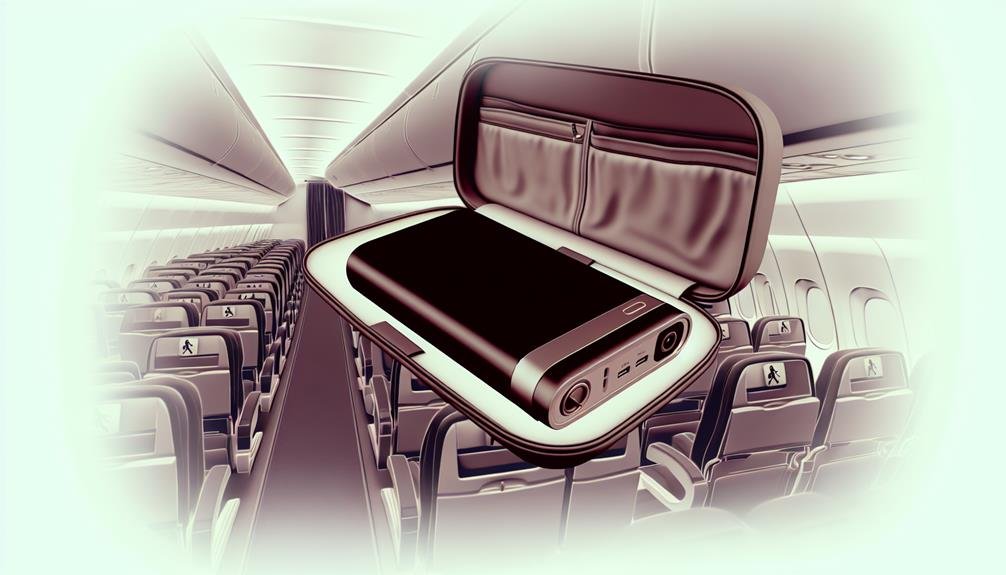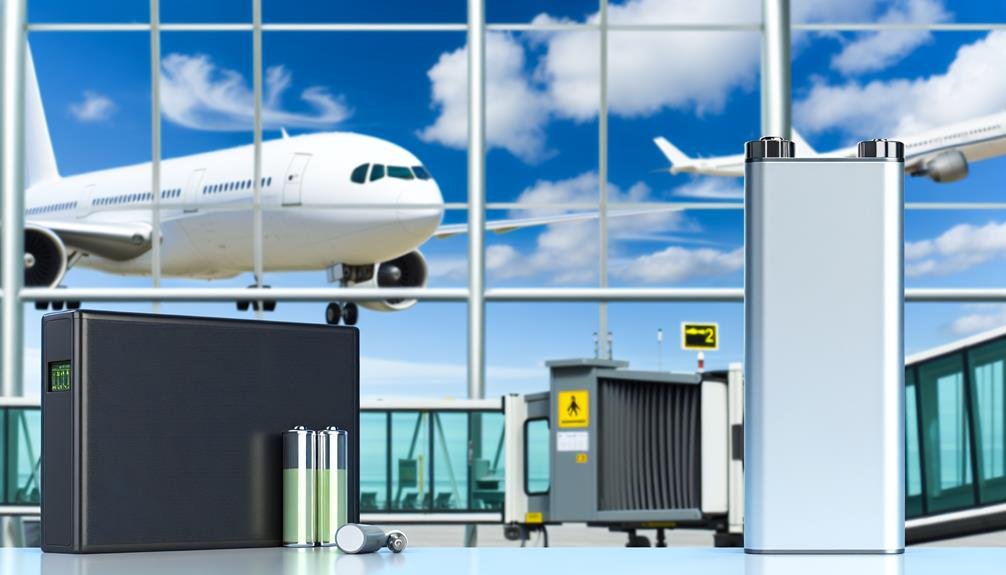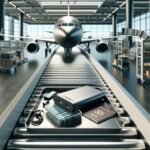You can bring a 30000mAh power bank on a plane, but there are strict regulations to follow. Airlines usually cap power bank capacity at 100Wh. To calculate, multiply mAh by voltage (typically 3.7V for lithium-ion batteries) and divide by 1000. Your power bank is about 111Wh, which may need airline approval since it's over 100Wh but under 160Wh. Always carry it in your carry-on, not checked luggage. Contact your airline to ensure compliance and prioritize safety. Staying informed about these regulations could make your travel smoother.
Airline Regulations

When bringing a 30000mAh power bank on a plane, it's important to understand and comply with airline regulations to avoid potential risks and guarantee a smooth travel experience. Airlines have specific power bank restrictions that you must adhere to, primarily due to the risks associated with high-capacity lithium-ion batteries. Each airline may have slight variations in their policies, so it's essential to review the specific airline policies for your carrier.
Typically, power banks with a battery capacity of up to 100Wh (watt-hours) are allowed in carry-on luggage, but those exceeding this limit may require special permission or might be prohibited entirely. For context, a 30000mAh power bank generally equates to approximately 111Wh, which is above the standard limit. This could subject your power bank to more stringent travel restrictions.
To guarantee compliance, contact your airline ahead of time to verify if your 30000mAh power bank is permissible and under what conditions. This proactive approach minimizes risks such as confiscation, fines, or delays. Prioritizing safety and regulatory adherence helps facilitate a trouble-free journey, maintaining both your peace of mind and the safety of all passengers.
Capacity Limits
Understanding capacity limits is vital when bringing a 30000MAH power bank on a plane. You need to know how to calculate the watt-hour (Wh) rating, as airlines often regulate power banks based on this measurement. Ensuring compliance with airline regulations is essential to avoid confiscation or travel delays.
Airline Regulations Overview
Most airlines impose strict regulations on the capacity limits of power banks, typically capping them at 100Wh to guarantee adherence with safety standards. Understanding these power bank restrictions is essential for making sure that you can pass through security checkpoints without any issues. Airline policies are designed to mitigate the risks associated with high-capacity batteries, which could pose fire hazards if not properly managed.
When you're packing for your flight, it's important to verify the capacity of your power bank. If it exceeds the 100Wh limit, you could face confiscation or be denied boarding. These battery size restrictions are enforced rigorously at security checkpoints, where all electronic devices are scrutinized. Make sure your power bank is clearly labeled with its capacity to avoid delays and complications.
Adhering to these regulations not only guarantees your compliance but also contributes to overall flight safety. The emphasis on regulatory compliance serves to protect all passengers by minimizing the risk of battery malfunctions during the flight. Always check specific airline policies before you travel, as some carriers may have even stricter rules. Safety should always be your top priority when it comes to carrying electronic devices on a plane.
Watt-hour Calculation
To verify your power bank complies with airline regulations, you'll need to calculate its watt-hour (Wh) rating, which is derived from its milliampere-hour (mAh) capacity and voltage. This is essential for guaranteeing your device meets safety standards and avoids confiscation. The formula for watt hour conversion is straightforward: Wh = (mAh × V) / 1000.
For a 30000mAh power bank, you typically encounter a voltage of 3.7V or 5V. Using the 3.7V standard, the calculation would be: (30000mAh × 3.7V) / 1000 = 111Wh. If your power bank operates at 5V, the calculation is: (30000mAh × 5V) / 1000 = 150Wh.
Most airlines permit power banks up to 100Wh without special permissions. Devices between 100Wh and 160Wh usually require airline approval. Power banks over 160Wh are generally prohibited.
Therefore, for a 30000mAh power bank, if it's rated at 3.7V, you might be right on the edge, but if it's at 5V, it's likely over the limit. Always check your device's specifications and review your airline's policies to ensure conformity and maintain safety. Accurate battery life estimation and adherence to regulations are vital for a hassle-free travel experience.
Lithium-Ion Battery Rules

When considering bringing a 30000MAH power bank on a plane, you'll need to comply with specific lithium-ion battery rules. Capacity limitations, set by aviation authorities, dictate whether your power bank can be carried on board. Be sure you're aware of airline regulations and follow necessary safety precautions to mitigate risks associated with high-capacity batteries.
Capacity Limitations
Airline regulations stipulate that lithium-ion batteries, including power banks, must adhere to strict capacity limitations to guarantee safety on flights. When considering a 30000mAh power bank, you'll need to be aware of multiple factors such as storage restrictions and weight limits. Here are key points to keep in mind:
- Watt-Hour Calculation: Most airlines limit batteries to 100 watt-hours (Wh). To calculate this for your power bank, multiply the voltage (V) by the ampere-hours (Ah). Exceeding this could lead to travel restrictions.
- Voltage Requirements: Confirm your power bank's voltage meets the airline's specified range. Typically, lithium-ion batteries should operate within 3.6 to 4.2 volts per cell.
- Storage Restrictions: Power banks must be stored in carry-on baggage, not checked luggage, to allow easy access in case of emergencies.
Understanding these rules confirms you're compliant and minimizes risks during air travel. Overlooking these details could result in confiscation or denial of boarding. Adhering to these guidelines not only helps with regulatory compliance but also maintains a safe environment for all passengers. Always check the latest airline-specific requirements before your flight.
Airline Regulations
Guaranteeing compliance with airline regulations for lithium-ion batteries, you'll need to understand specific rules that govern their transportation. Airlines impose power bank restrictions primarily based on the watt-hour (Wh) rating of the battery. For a 30000mAh power bank, you must first convert its capacity to watt-hours. Typically, this is done using the formula: (mAh/1000) x Voltage. Assuming a standard voltage of 3.7V, a 30000mAh power bank equates to 111Wh.
Airline regulations for electronics usually permit power banks up to 100Wh to be carried in your carry-on luggage without prior approval. Since your power bank exceeds this limit but is under the 160Wh threshold, you'll likely need airline approval before bringing it onboard. Some airlines might also impose a limit on the number of such high-capacity batteries you can carry.
Strictly adhering to these regulations minimizes safety risks, such as overheating or fire hazards, associated with lithium-ion batteries. Always check the specific airline's guidelines on power bank restrictions before your trip. This guarantees you're not caught off guard at the airport and helps maintain a safe travel environment for all passengers.
Safety Precautions
Given the potential hazards associated with lithium-ion batteries, it's important to adhere to safety precautions to mitigate risks such as overheating or fire. These batteries, while efficient, can pose significant dangers if not handled correctly. To guarantee your power bank is both safe and compliant, consider the following guidelines:
- Voltage Limits and Charger Compatibility: Always check the voltage limits of your power bank and verify it's compatible with your charger. Over-voltage can lead to overheating, posing a fire risk. Use only the manufacturer-recommended chargers to avoid potential hazards.
- Charging Habits: Develop good charging habits to extend your battery lifespan and guarantee safety. Avoid overcharging by unplugging your power bank once it's fully charged. Overcharging can degrade the battery over time and increase the risk of malfunction.
- Regular Inspections: Frequently inspect your power bank for any signs of damage or wear. Look for bulging, leakage, or unusual heat during charging. If you notice any irregularities, stop using the power bank immediately and seek professional advice.
Carry-On Vs. Checked Luggage
When considering whether to bring a 30000mAh power bank in your carry-on or checked luggage, understanding airline regulations and safety risks is essential. According to TSA guidelines, lithium-ion batteries, such as those found in power banks, are prohibited in checked luggage due to their potential fire hazard. Airport security measures are stringent to guarantee passenger safety, and compliance with these rules is non-negotiable.
For travel essentials, particularly electronic devices, power banks must be carried in your carry-on luggage. This rule is in place because if a battery malfunctions or overheats, the cabin crew can address the situation promptly, reducing potential risks. Power banks over 100Wh (watt-hours) generally require airline approval, and a 30000mAh power bank often exceeds this limit, warranting prior consultation with your airline for specific guidelines.
Ensuring regulatory compliance protects not just your devices but also the safety of everyone on board. Always check the latest TSA guidelines and your airline's policies before traveling. Properly storing your electronic devices and adhering to airport security protocols can make your journey smoother and safer. Remember, safety starts with informed preparation.
International Guidelines

Understanding international guidelines for bringing a 30000mAh power bank on a plane requires comprehending the specific regulations of each country and airline to guarantee adherence and safety. Battery restrictions vary globally, so knowing these rules is a travel essential. Here's how you can navigate them effectively:
- Country-Specific Regulations: Different countries have unique guidelines regarding battery capacity. For example, the European Union and the United States often follow International Air Transport Association (IATA) recommendations, allowing batteries up to 100Wh without prior approval. However, always check the specific country's aviation authority rules before traveling.
- Airline Policies: Airlines often have their own regulations regarding power banks. Some airlines may restrict power banks over a particular capacity or require them to be in carry-on luggage only. Always review the airline's battery restrictions before your trip to avoid confiscation at security checkpoints.
- Safety Protocols: Assure your power bank has clear labeling of its capacity (mAh or Wh) and is from a reputable manufacturer. Non-compliance can lead to confiscation or fines, so proper documentation is essential for risk assessment and regulatory adherence.
Tips for Safe Travel
Verifying your power bank meets airline specifications is crucial for a hassle-free travel experience. First, confirm that your 30000MAH power bank complies with the airline's watt-hour (Wh) restrictions, typically not exceeding 100Wh without prior approval. Calculate the Wh of your power bank by multiplying its voltage (V) by its capacity (Ah), making sure it aligns with regulatory standards.
When packing essentials, your power bank should be in your carry-on, not checked luggage, as per TSA regulations. This minimizes risks related to potential overheating or short-circuiting. Use a protective case to prevent physical damage, and make sure it's easily accessible for inspection at security checkpoints.
Additionally, familiarize yourself with travel accessories designed to enhance safety, such as fire-resistant storage bags. These can mitigate risks associated with lithium-ion batteries.
At security checkpoints, be prepared for additional scrutiny. Remove the power bank from your bag and place it in a separate bin for X-ray screening. Follow TSA guidelines meticulously to avoid delays and security concerns.
Frequently Asked Questions
Do I Need to Declare My Power Bank at Airport Security?
You should declare your power bank at airport security to comply with power bank regulations. Familiarize yourself with the guidelines to guarantee safety and regulatory compliance, reducing any risk during your travel. Always prioritize adherence to airport security measures.
Can I Use My Power Bank During the Flight?
Yes, you can use your power bank during the flight, provided it's within airline regulations. Using electronic devices is allowed, but make sure your power bank's battery life and charging options comply with safety guidelines to minimize risks.
Are There Specific Brands of Power Banks That Are Banned?
You're asking about power bank regulations and brand restrictions. Generally, airlines don't enforce specific brand bans, but they do focus on capacity limits and safety standards. Always check airline guidelines and make sure your power bank complies with regulations.
What Should I Do if My Power Bank Gets Damaged During the Flight?
If your power bank gets damaged mid-flight, don't panic! Immediately start the compensation process and explore replacement options. Check your travel insurance for electronic device coverage to make sure you're following regulatory compliance and safeguarding your trip.
Can I Bring Multiple Power Banks With a Combined Capacity of 30000mah?
Yes, you can bring multiple power banks, but make sure each power bank capacity doesn't exceed 100Wh. Adhere to airline restrictions on power banks to avoid safety risks and regulatory compliance issues during your flight.



